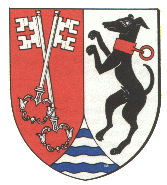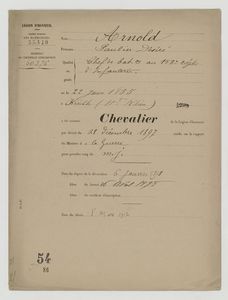From Brother Joseph PETER of BITSCHWILLER (1979)
An old coat of arms reminds us of the past of ODEREN. In those days, the village was called "ALTODURUM" which means: fortified refuge on a hill "Hohenburg". Over time the name Altodurum was altered to eventually become "ODR." The blazon shows a mountain top fortification with a tower in the middle. On the right side, three birds are flying over the tower “ODR.” At the foot of the mountain are fir trees in the middle a tuft of grass. Below is this blazon as it is today with the dog of the Abbey of MURBACH, which ODEREN was dependant upon.

Date of 1976
Parti, au premier de gueules à deux clés d'argent posées en sautoir,
au second d'argent au lévrier de sable colleté de gueules, enté en pointe, d'argent
The names of villages and their environs reveal which populations were settled in these places. An example which remains very important is the name of the village of ODEREN, its environs and gaps.
The word ALTODURUM inspired Charles ROSTAING, an emeritus professor at the University of the Sorbonne in Paris who answered to Abbot PETER, to wonder about the interpretation of the name. It was composed of "ALT" which means HIGH and "DURUM" which means Citadel, fortified refuge or Fort, a hillock one hundred meters high which dominates the village and which today has a church where the Fort was. The "O" links the two words together.
With phonetic development, "ALTODURUM" became Odèr, accented on the è. But the last occupiers of the area, the Alamans, put the accent on the "O." This contributed to its evolution to the word "ODR" which is now: ODEREN.
The toponym ODR doesn’t come from "ADER" (vein) and it fits well with the other names of archaic places which surround the village.

ODEREN in 1950
Above Dürrembach Street are two clumps of houses called "Klein-Cosch" and "Gross-Cosch." Professors DAUZAT and ROSTAING explain that the names came from the indo-european "Kukk" or "Cucc." In the Alpes, there are many "Cosges" and in the South of France many "cuges" all situated, without exception, on rises in the ground. We know that Dürrembach Street climbs to reach the "Tschar." When we continue on the road through Cosch we arrive at Tschar (the place where my ancestors lived during the last century). This name is also pre-Indo-European and refers to stony places. Its root comes from "kar" which in the speech of our ancestors became "Tschar".
From the same root comes the toponym "Altscher"... "Al" in indo-European means height! Al-Tschar became ALTSCHER which is a stony hill above the village.
We find the following detail in the name of "Kalafelsen" which refers to a high stony massif in the North of "Suterlay". The Alamans who formed the doublet "Kalafelsen" couldn’t know that "Kala" and "Felsen" referred to the same thing. From "Kala" (Cala) comes the word Calamis, in abbreviated form, "calm." "Calm" became "Schalm" in ODEREN and refers to a stony land near "HINTERGOTT". From Calamis came the word "Chaumes", which is the name given to stony pastures in the High Vosges!
The "TREH" is one of these Chaumes (stony pastures). This word, formed by the pre- indo-European "tr" or "ter" = "tritus" in Latin and "tresk" in pre-German, is also the word "Tresk." “Tresk” became "dreschen" and means: to tresch, to fell, to do a felling, the cutting down of trees. Trêh is the base. We know that in the old days the crests were wooded and were deforested by breeders in order to make summer pastures.

High pastures "le Honeck" around 1950
The street on the west side of Oderen is called the "GORT". This toponym has the root "Gher", "Ghor" becomes "chortos" in Greek, "hortus" in Latin and "cort" in Celtic. It means "enclos" (enclosure) of a fortified place. This defensive refuge was on the steep hillock where now the church and the graveyard, surrounded by a strong wall are.
When we cross the bridge at the end of the street of the Gort, we arrive at a clump of houses called "RITSCHA". This toponym is formed from Gaulish "ritu" or “rit” which refers to a ford. The sound was forded before the building of the bridge over the Thur. The other word which formed Ritscha is the Celtic "caé" which means house and which became "Tscha". So the RITSCHA is the hamlet near the ford.

The district of the street la Gortunder the hillock of the church
Another place in the Vosges is the "BRECHEL," a diminutive of "Breuche" as Breuchettes and Breuchaules in the area of Remiremont, which means: groundworks.
Near the "Bréchel" is the "GRANDSCHE". Very often people in the Vosges pronounce "Champ" as "ché". The Gransché is a big field, the Rundsché or Rondché or RUNSCHE in KRUTH is a round field, (the first place where lived Claude ARNOLD when he settled in KRUTH).
A little further away is the "Taschlé," a word coming from the low-Latin "taxo" which became "taisson" in old French and "Daschs" in German. The "TASCHLE" is a place where there was a den of badgers. The "BRAY" is a meadow in the North of ODEREN, of the THUR. This word comes from the low-Latin "Bracium" which means "terrain humide" (humid land) and was in the old days the "Brayweiher".
Above the Tschar we can see a little round and symmetrical hillock on which there is a tree called the "GUMMKOPF" - GUMM comes from Celtic "cumba" become "comm(e)" with a mute "e" which means a depression in the form of a U-shaped valley. In this high concave small valley rises the Gummkopf as a big kougelhof!!! (a dome shaped specialty cake of Alsace).
The "MAREL" or MAËRLE is a hamlet of ODEREN. The name comes from "Märelweiher." Situated at the bottom of the clump of houses is a kind of little pool or “mer” (sea) or lake... but here the “mérelle” is a pool. It is well-stocked with fish. So the word Märelweiher is a doublet, a tautology, its two components coming from the same thing. Alamans created this word but didn’t know the meaning of "Mérelle".
When we leave ODEREN to go to KRUTH we can see on our right the "FONTAY" field and forest. This word is Vosgien and means fountain. It is formed from "font" and the collective suffix "aille".
Stone polished axes have been found, one at the TREH and another one in ODEREN. They are dated from the Neolithic Age, 3000 BC. In the Märel pool have been discovered remains of pilotis (piling), proofs of a lake dwelling. (Pfahlbauten, palafittes).
We don’t really know the name of the first small tribes who lived in this area but it is said that the first prehistoric inhabitants may be the Basques (Vascones).
Historians who admit this possibility interpret the "Vogesus Mons" as the mountain of the Basques. So, the WASGENWALD, WASGAU, WASIGENSTEIN, would recall the presence of Basques in the Vosges! They would be pushed back by the Ligures, the Ligures by the Gauls and the Romanized Gauls by the Alamans. In this succession of small tribes, conquerors kept some names of places of the defeated, as we can see in Oderen and its environs.
A Castellum seems to be in Kastelberg, also on the Marelberg, where they could control the valley. In the Marelweiher, Roman gold coins dated around 400 AD have been found... ODEREN had its treasure, and today it is a very charming village full of flowers where we are pleased to live all along the year.
To be continued with the toponym Kruth...
M.A.T. sources : Les noms des lieux et des lieux-dits dans la vallée de Saint-Amarin par Fr. Joseph PETER Prêtre retraité de Bitschwiller les Thann - collection ASS.I.F.ARNOLD – all rights reserved.
Toute reproduction partielle ou totale de ce blog est strictement interdite conformément à l'article L.112-1 du Code de la Propriété intellectuelle sauf autorisation préalable de l'auteur.













/https%3A%2F%2Fstorage.canalblog.com%2F42%2F66%2F261813%2F10856917_o.jpg)